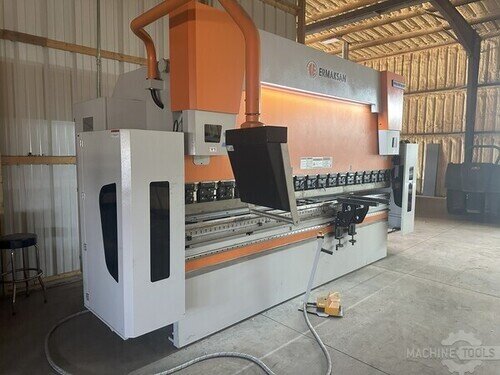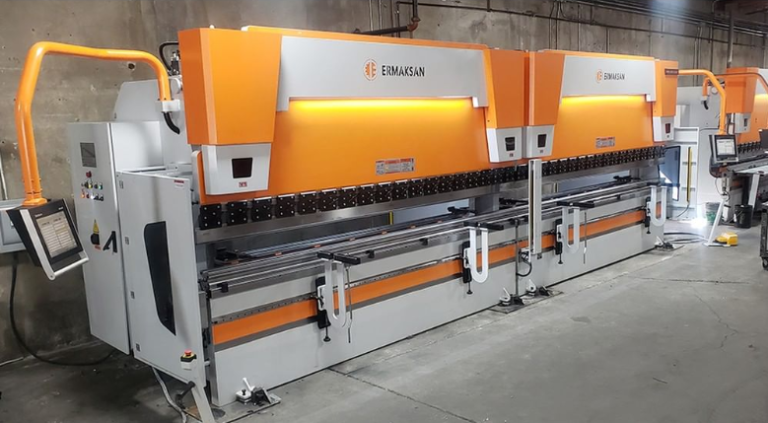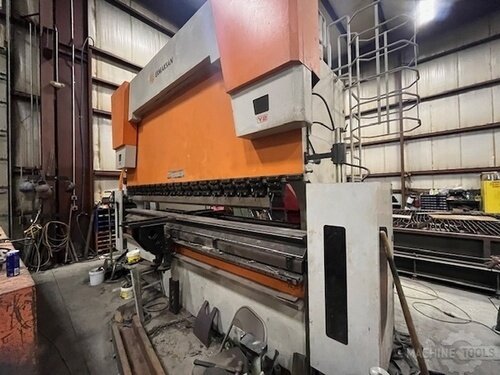Indiana Shops: Tandem Press Brakes, Full-Length Flex; Section 179 by Dec 31
As President of Mac-Tech, I spend my days helping fabricators plan investments that improve flow, lower risk, and produce measurable profit. Tandem press brakes have become a strategic lever for Indiana and regional shops that need to bend long panels without bottlenecks while keeping flexibility for short-run work. Paired with Section 179 and current financing options, there is a clear path to justify a purchase and place it in service before December 31. If you want to discuss the fit for your plant, reach me at joe@mac-tech.com or 414-477-8772.
Indiana Competitive Edge with Tandem Press Brakes: Full-Length Bending, Large Panel Consistency, Fewer Welds
Tandem press brakes link two matched CNC brakes into one synchronized system for long parts, then split apart for independent use on everyday components. Typical configurations include dual hydraulic or hybrid brakes with Y1 Y2 axis control, active crowning, and multi-axis backgauges. The controls coordinate both machines so they behave like one long bed when needed, then revert to two standard brakes for short work. That flexibility gives Indiana shops the ability to quote big agricultural panels, trailer skins, racking uprights, and enclosure bodies without outsourcing.
Large panel consistency improves when the system uses real-time ram synchronization, crowning, and staged tooling. By bending a long part as one piece, you reduce distortion from weld heat, eliminate mismatch at seams, and cut hours of fit-up. The result is better geometry on doors, hoods, and frames, fewer rework loops, and a stronger product in the field.
Fewer welded seams mean fewer failure points and a cleaner cosmetic finish. Shops routinely report that moving from two or three welded sections to one formed part improves first-pass yield and cuts downstream grinding. That boosts throughput without adding headcount.
Flow and Labor Optimization: Setup Reduction, Tooling Strategy, and Crane Logistics for One-Piece Part Movement
The fastest ROI on tandem brakes comes from flow improvements. We engineer staged tooling so operators run families of bends without tearing down setups. Quick-clamp WILA style or American precision clamping with segmented punches and dies keeps changeovers measured in minutes. Shared tool libraries between the two brakes allow mirror staging so either machine can take over a short part while the other stays ready for a long panel.
Material handling is often the hidden cost. We plan crane reach, vacuum lifters or sheet followers, and safe approach paths so one-piece panels travel once from laser to brake to assembly. When operators can rotate, support, and square a 10 to 30 foot part with sheet followers and a well planned gauge strategy, you remove the second person at the station and the delays that come with it.
Programming and job release also affect labor. Offline bend simulation with automatic tool selection reduces trial bends and keeps both brakes busy. Barcode job calls and standardized bend sequences let supervisors move work seamlessly between the two frames based on capacity. That turns a hard constraint into a flexible cell.
HEAVY DUTY
TANDEM PRESS BRAKE
Measurable ROI: Cycle-Time Gains, Scrap Avoidance, and OEE Uplift That Justify Capital
We model ROI around three drivers. First, cycle time per part drops when long panels run in one shot. A single-piece 12 foot part on a tandem system typically replaces two or more short pieces plus fit-up and welding, which can remove hours per job. Second, scrap avoidance increases with 3D bend simulation, backgauge automation, and angle measurement options that catch mistakes before they become bad parts. Third, OEE rises because the same capital runs as one long brake during peaks and as two independent brakes during mixed work.
Quality improvements are quantifiable. Eliminating weld distortion removes rework hours and lowers consumables. Angle control systems, such as laser angle measurement or adaptive bending sensors offered by many OEMs, stabilize first-part quality. That lifts the quality component of OEE and tightens delivery promises, which supports better pricing and win rates.
We routinely see payback in 12 to 24 months when the cell replaces welding and secondary finishing. The cockpit view comes from dashboards in the CNC control and from your ERP, where we track planned cycle times against actuals, scrap tags per order, and machine availability. Those metrics make the capital case clear to finance.
Funding the Upgrade: Section 179 by Dec 31, Bonus Depreciation, and Lease Structures That Protect Cash
Section 179 allows many businesses to expense the full purchase price of qualifying new or used equipment that is purchased and placed in service by December 31, subject to annual limits and phase-outs. That immediate deduction often offsets a major share of the first year outlay. For Indiana shops on a calendar fiscal year, this is a now decision, not a next year idea. Always confirm details with your tax advisor.
Bonus depreciation remains available at a reduced percentage compared to prior years and can complement Section 179 when you exceed expensing limits. The combination can create a powerful first-year tax benefit. Again, coordinate with your CPA to match deduction methods to your profitability and carryforward strategy.
Financing can align with those tax benefits. We arrange $1 buyout leases for owners who want equipment on the balance sheet, and fair market value leases for lower payments and flexibility. Step or deferred payments can push cash outflows into the months when the brake is producing revenue. Section 179 can apply to financed equipment as long as it is placed in service by year end. Our team coordinates delivery, commissioning, and acceptance to meet that requirement.
Digital Controls and Integration: Offline Programming, Bend Simulation, and ERP Connectivity for Predictable Throughput
Modern tandem systems ship with proven CNC controls from leading builders. Features typically include 3D offline programming, automatic bend sequencing, tool selection based on your library, and accurate simulation of collisions and backgauge moves. This shifts programming off the floor, reducing setup and freeing operators to run parts.
Angle measurement and adaptive bending improve consistency on long flanges and varied materials. Active crowning compensates for deflection across the full length. Multi-axis backgauges guide complex parts, while sheet followers support large panels to protect edges and reduce operator strain.
For planning and traceability, we connect the brakes to your ERP or MES through the control OEM’s software, barcodes, and common protocols such as OPC UA where available. Production data, part counts, and run times return to the office in near real time, so scheduling reflects actual capacity and promises remain reliable.
Partnering with Mac-Tech: Application Engineering, Commissioning, Training, and Lifecycle Service for Sustainable Growth
Our process starts with a plant walkthrough and a part study. We group parts by length, thickness, and bend families, then design a staged tooling strategy and handling plan. We verify floor loading, power, crane coverage, and safety zoning. When needed, we coordinate foundations, guarding, and e-stop integration with your safety team.
During commissioning we align both frames, calibrate the backgauges, link the controls for tandem synchronization, and run your parts for acceptance. Operators and programmers receive hands-on training that covers staging, offline programming, and best practices for long panels. Your maintenance team gets a preventive maintenance schedule and spares list.
Lifecycle support matters. We provide remote assistance, on-site service, periodic laser calibration checks, and refresh training as your team and product mix evolve. As production grows, we can add sheet followers, angle systems, or additional tooling to extend capability without disrupting flow.
FAQs
What industries in Indiana benefit most from tandem press brakes?
Agriculture, trailer and upfit, materials handling, HVAC duct and large enclosure builders gain the most due to frequent long panels and the need to cut weld time.Do tandem systems lock me into only long parts?
No. Each brake can run independently. You can bend two different short jobs at once or synchronize for long parts when orders require it.Can used tandem press brakes qualify for Section 179?
Yes. Section 179 generally covers new or used equipment that is purchased and placed in service by December 31, subject to limits and eligibility. Confirm with your tax advisor.How do we estimate ROI before buying?
We model current weld and fit-up hours, setup time, scrap rates, and machine availability. Then we simulate staged tooling and offline programming to project cycle time and OEE improvements.What financing structures work best for year end?
Many shops use a $1 buyout lease or fair market value lease with step or deferred payments, timed so the asset is in service for Section 179 while cash outflow aligns with production.How hard is ERP integration?
Most modern controls support job import, barcodes, and data export. We map items and routings, then pilot on a few parts before scaling. The goal is reliable scheduling and accurate labor reporting.- What safety considerations come with long panels?
Plan for light curtains or AOPD, sheet followers, safe crane paths, and clear lines for communication. We include these in the layout and training.
I am Joe Ryan, President of Mac-Tech. If you want a practical plan to add full-length bending capacity and capture Section 179 by year end, contact me at joe@mac-tech.com or 414-477-8772.
Get Weekly Mac-Tech News & Updates







